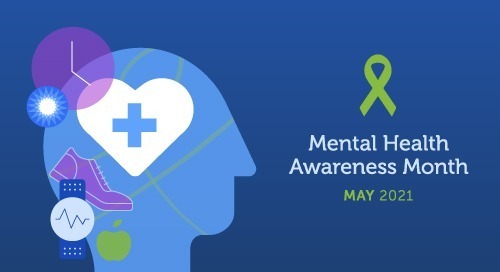It’s Mental Health Awareness Month.
If hindsight is 20/20, then it is no secret this past year presented many challenges and obstacles that tested our strength and resiliency.
The global pandemic forced us to cope with situations we never even imagined, and a lot of us struggled with our mental health as a result. Many teams worked from home for the first time. Employees with children engaging in distance learning had the added challenge of also being a teacher while working full time. Managing a household, while combating the fear of the unknown, led to increased anxiety and/or depression. This often directed itself to self-care methods that were not healthy:
- lack of sleep;
- loss of routine;
- comfort eating;
- alcohol consumption;
- and more.
If you’re one of these individuals, don’t fret — you’re not alone. In fact, the Centers for Disease Control and Prevention (CDC) discovered that by June 2020, more than 40% of adults (2 in 5) reported struggling with mental health or substance abuse – a sharp increase from the traditional number of just 20% or 1 in 5 adults.
Throughout the pandemic, many people who had never experienced mental health challenges found themselves struggling for the first time and had impacts on productivity, absenteeism, employment attrition, and poor work performance. Now, more than ever, it is critical to reduce the stigma around mental health struggles that commonly prevents individuals from seeking help.
As we kick off Mental Health Awareness Month, it is time to encourage all employees – in office and remote – to take charge of their mental health and thrive. Did you know that while over 90% of employers offer mental health services, 87% of millennials and 82% of Gen Z think employers should do more to promote their mental health programs in the workplace?
Employees are asking for more – so what can you do to help them feel taken care of?
Encourage More Use of the EAP Program
Mental Health Programs such as the Employee Assistance Program (EAP) can be found in 97% of companies, but the utilization rate is less than 10%.
The EAP offers a limited number of in-person visits to a therapist based on a single issue at no cost to the employee – and even extends this offer to members of the employee’s household, such as a spouse or child. If the issue requires immediate attention, a telehealth visit is available for about 30 minutes as many times as needed, 24 hours per day and seven days per week. Most therapists are in-network and take various insurances, so if an issue needs further discussion, visits can continue at a nominal cost.
Here are some easy ways to encourage more use of the EAP program:
- Let employees know the program exists. Employees cannot use the program if they don’t know that it exists. Send quarterly reminder emails to remind them about the program. You should also post the information in the break room and/or on the company intranet.
- Describe what the program is. Therapy can be expensive, but EAP gets the ball rolling with anywhere between 3-6 sessions covered by the employer. Let employees know what details are included, so they can make better decisions about their mental health and well-being.
- Promote! Promote! Promote! Open enrollment is a great time to share details about the program and how it’s included for all employees, even if they’re not on the company insurance plan.
Other Ways to Offer Assistance
Banishing burnout is no easy task — and thankfully, employers are putting a focus on employee mental health and well-being as stay-at-home mandates continue on. While some employers may be behind and are trying to roll out programs this year, others have already moved swiftly to provide their employees resources to improve work-life balance.
Here are some ways employers are using resources to help employees find calm in the chaos.
- Flexible Scheduling. Ask your team what hours work best for them and schedule them based on priorities. A true work-life balance allows for employees to flex their schedules to meet the needs of their households. Some may want to start their workday earlier and others may want to start later and finish in the evening.
- Take Regular Breaks. Remind your team to take lunch and regular breaks. Breaks allow your team to rest, reset, and recharge. It can be something as simple as taking a walk outside.
- Use Vacation Time. This is particularly important for remote employees: it can be easy to forget that while working from home that we’re still working. Remind employees to use their vacation days and to enjoy the time off without feeling pressured to check email while out of the office.
Mental Health Awareness Month: Accurate is here to help!
Today we begin Mental Health Awareness Month, and this year’s theme #Tools2Thrive — an initiative to ensure that employers have all the tools in their tool kits to help ensure that mental health is a priority in the workplace.
It’s important to remember that working on mental health and finding tools that help your employees thrive takes time. Change won’t happen overnight. Instead, by focusing on small incremental changes, your team can move through the stressors of the past year and develop long-term strategies to support themselves on an ongoing basis.
During the month of May, Accurate Background will post tips/tricks on its social media channels to help focus on these small changes by doing one small change per day.
You can also download our tip sheet and review more than two dozen ideas to help your team thrive during uncertain times.



